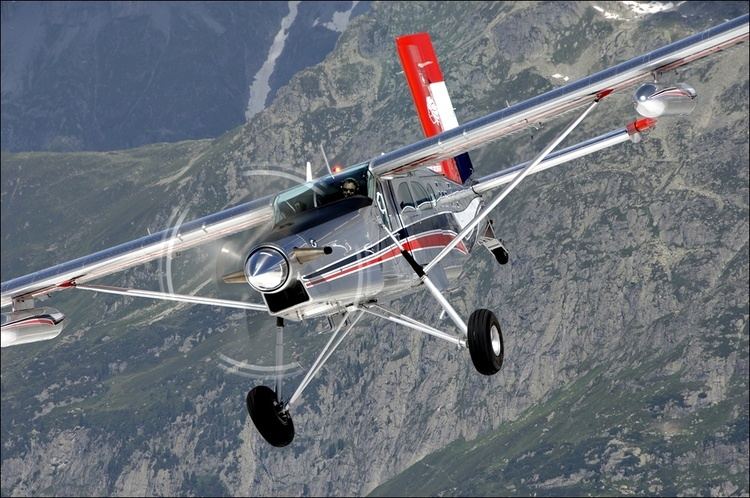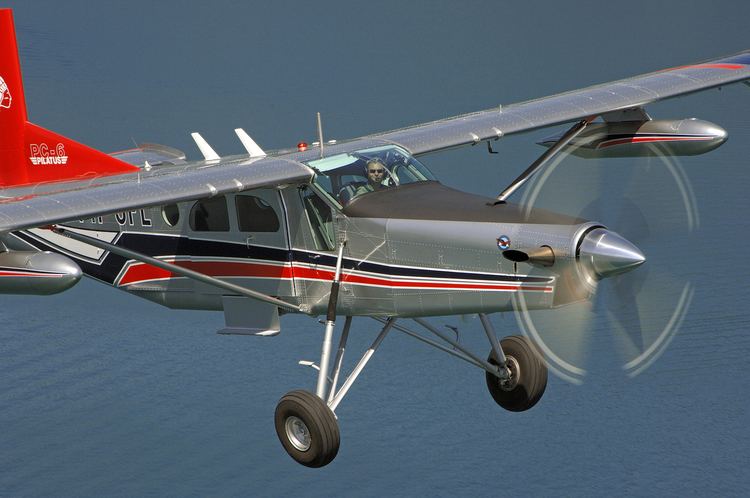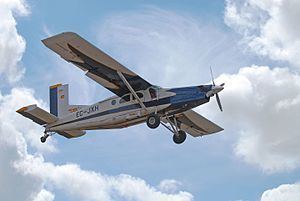Top speed 244 km/h Length 11 m | Wingspan 16 m First flight May 4, 1959 | |
 | ||
The world models pilatus pc 6 porter 40 kit balsa kit building
The Pilatus PC-6 Porter is a single-engined Short Takeoff and Landing (STOL) utility aircraft designed by Pilatus Aircraft of Switzerland. First flown in 1959, the PC-6 continues in production at Pilatus Flugzeugwerke in Stans, Switzerland. It has been built in both piston engine- and turboprop-powered versions and was produced under licence for a time by Fairchild Hiller in the United States.
Contents
- The world models pilatus pc 6 porter 40 kit balsa kit building
- Development
- Design
- Operational history
- Variants
- Current military operators
- Former military operators
- Law Enforcement operators
- Civil operators
- Former civil operators
- Accidents and incidents
- Specifications PC 6 B2 Turbo Porter
- References

Development

On 4 May 1959, the first prototype, powered by a 254 kW (340 shp) piston engine, made its maiden flight. In early May 1961, the first Turbo Porter, powered by a Turbomeca Astazou II turboprop engine, performed its initial flight. In comparison to its earlier piston engine-powered incarnation, the Astazou II-equipped Turbo Porter had an increased gross capacity and top speed, as well as benefitting from the engine's automatic handling functions. These benefits came at the expense of a greater initial purchase cost and higher fuel consumption. Both the piston and turbine-engine versions of the PC-6 became quickly known for their Short Takeoff and Landing (STOL) capabilities, requiring only a very short takeoff run before being ready for rotation prior to taking off.

The initial turbine-powered models of the PC-6 were equipped with the Astazou II powerplant, however complaints of the reliability of this engine were made. Another early turboprop powerplant that became available for the PC-6 was the Garrett Air Research TPE 331. Some operators such as Air America chose to retrofit their Astazou II-powered PC-6s with the TPE 331 engine in its place. In May 1996, the first PC-6 to be equipped with the Pratt & Whitney Canada PT6A engine performed its maiden flight.

To offset rising labour and manufacturing costs in Switzerland, Pilatus distributed manufacturing work on the PC-6 to other countries; in 1993, Czech Republic-based Letov Kbely began manufacturing activity upon the type. In 2013, Pilatus formed a joint venture with Beijing Tian Xing Jian Yu Science Co., Ltd. to locally manufacture the PC-6 and the newer Pilatus PC-12 in Chongqing, China; initially this facility performed subassembly work on the fuselage, and later other elements such as the wings and moving surfaces, which were conveyed to Pilatus' final assembly facility in Stans, Switzerland. Global production of the PC-6 shall be eventually transferred to the Chongqing facility. On 11 December 2014, the first Chinese-assembled PC-6 fuselage was completed. In 2014, the majority of PC-6s delivered that year were to Chinese customers. By April 2016, around 20 PC-6s were in operation in the Chinese market; the type has often been used to replace the Antonov An-2, being reportedly cheaper to operate.

The Porter was also manufactured under license by Fairchild Hiller in the United States. Roughly 100 of these licence-produced aircraft would be completed, being mainly purchased by civil operators within the US. A number of Fairchild Hiller-built PC-6s were also procured for military operations during the Vietnam War. It received the designation AU-23A Peacemaker for service with the U.S. Air Force. The Peacemaker was fitted with a side-firing 20mm XM-197 Gatling cannon, four wing pylons and a centre fuselage station for external ordnance. However, the AU-23A proved to be troublesome in service. All of them were returned to the continental U.S. and placed into storage after only a single year of operation. In 1979, a pair of UV-20s were assigned to the aviation detachment of the Berlin Brigade in Germany due to their suitability for operating within the heavily restricted airspace; they were fitted for carrying either cargo, up to eleven passengers, or three litters with four medical attendants.
Design

The Pilatus PC-6 Porter is a Short Takeoff and Landing (STOL) utility aircraft. The majority of aircraft are powered by a single Pratt & Whitney Canada PT6A turboprop engine, which drives a fully reversible, constant-speed, three-bladed HC-B3TN-3D (or an alternative four-bladed HC-D4N-3P unit) Hartzell aluminium propeller via a reduction gearbox. Pilatus claims that it possesses unique STOL capabilities, capable of landing in places only otherwise accessible by rotorcraft. It is fully capable of being operated from unprepared rough airstrips, in remote areas, hot climates and at high altitudes in all-weather conditions. In particular, the undercarriage employed provides for high wing and propeller clearances, making the PC-6 less susceptible to damage than conventional nosewheel-type undercarriages. For further landing versatility, various types of landing gear may be optionally installed allowing it to operate from different types of terrain; options include floats for water landings and skis for landing on snow.
Early models of the PC-6 were equipped with a full instrument panel as standard, and were reportedly easy for unfamiliar pilots to intuit. Later-manufactured PC-6s are equipped with a Garmin G950 glass cockpit in place of analogue instrumentation; the majority of earlier-produced PC-6s can also be retrofitted with a glass cockpit as well. In addition to its flight functionality, the G950 system acts as a remote maintenance unit and electronic flight bag all in one. Two large 10.4-inch liquid-crystal displays (LCDs) are present, functioning as the Primary Flight Display for all key flight information and the Multi-function Display for system/mission management respectively; fully independent secondary flight instrumentation is also provided to provide backup altitude, attitude, and airspeed information in the event of complete electrical failure. The cockpit has been designed for single pilot operations; additional flight controls for a co-pilot can be optionally fitted. Other optional features include an autopilot (capable of operating within all phases of flight), traffic collision avoidance system (TCAS), terrain awareness and warning system (TAWS), weather radar, satellite phone, LIDAR, forward-looking infrared (FLIR) and lightning detector; in addition, onboard electrical and avionics equipment are readily modifiable to conform with customer requirements.
The airframe is of a rugged and low-maintenance construction; featuring high levels of accessibility, interchangeability, and favourable manning levels. The wings, fuselage, and empennage are manufactured using conventional semi-monocoque construction techniques, the primary structure being composed of aluminium; the central structure retains critical strength despite the cutout areas for the sliding doors of the main cabin. Corrosion resistance is achieved via a combination of plating and a polyurethane-based enamel paint. The simple nature of the structure allows for ease of repair in the field. Features such as low-pressure tyres, twin-clipper disc brakes, and a highly energy-absorbent undercarriage enable the aircraft to be capable of operating from rough or otherwise challenging terrain.
For role flexibility, individual aircraft can be easily converted between various mission types, such as transport, paradrop, aerial photography, surveillance, air medical services and search and rescue duties. A maximum of ten passengers, or a 2,200 lb payload, may be carried within the aircraft's main cabin area within the rear section of the fuselage; the standard passenger seats are designed to allow for rapid removal and may be stowed within an optional separate externally-accessed seat stowage compartment behind the main cabin. The main cabin area is furnished with soundproofing measures, ventilation, and heating as standard. A maximum of three fuel tanks can also be carried in the main cabin, accordingly reducing payload capacity, to increase the aircraft's flight endurance. In addition to the large sliding doors at either side of the main cabin, separate hinged doors are present on either side of the cockpit; an optional pilot-controlled trapdoor, to accommodate supply drops or surveillance payloads, may also be installed in the center of the cabin floor without any design changes required. Additional equipment include a firefighting system, aerial application system, underwing tanks, sand filters, propeller de-icing system, mudguard, tailwheel debris guard, oxygen system, and additional power distribution system.
Operational history
The PC-6 is noted for its Short Takeoff and Landing (STOL) performance on almost any type of terrain - it can take off within a distance of 640 feet (195 m) and land within a distance of 427 feet (130 m) while carrying a payload of 2,646 lbs (1,200 kg). Thanks to its STOL performance, the PC-6 holds the world record for highest landing by a fixed-wing aircraft, at 18,865 feet (5,750 m), on the Dhaulagiri glacier in Nepal.
Due to the type's favourable STOL characteristics, described by Flying Magazine as being "one of the most helicopter-like airplanes in terms of takeoff performance", Pilatus has deliberately marketed the PC-6 towards helicopter operators at times, feeling the type to be complimentary to their typical mode of operation. According to Pilatus, the PC-6 can provide very similar surveillance capabilities to a rotorcraft at a significantly lower cost to operate and procure.
During its early service, the PC-6 Porter was noted for its high level of comfort and usability against competing aircraft. The type has also proven to have a long service life; by 1993, roughly 440 of the 500 PC-6 Turbo Porters completed by that point were still in service.
During the 1960s and 1970s, the Central Intelligence Agency (CIA)-controlled airline Air America operated up to 23 PC-6s at a time. Many of these were operated in the South-East Asia region, including South Vietnam during the Vietnam War. The type was used for various missions including paradropping supplies to troops, passenger transport, psy ops, reconnaissance, prisoner conveyance, airborne radio relay, and other intelligence operations.
Since 1976, the Austrian Air Force has operated a fleet of 12 PC-6 Porters as the mainstay of their fixed-wing transport fleet; the type has been used in various support roles, including transport, Search and Rescue, firefighting, observation, target-towing and paradropping.
According to Flying Magazine, around 40 per cent of all PC-6s in use in Europe during the early 1990s were being used by skydivers.
Variants
Current military operators
Former military operators
Law Enforcement operators
Civil operators
Former civil operators
Accidents and incidents
Specifications (PC-6 B2 Turbo-Porter)
Data from Jane's All The World's Aircraft 1993–1994, Pilatus Aircraft, Flying Magazine.
General characteristics
Performance
